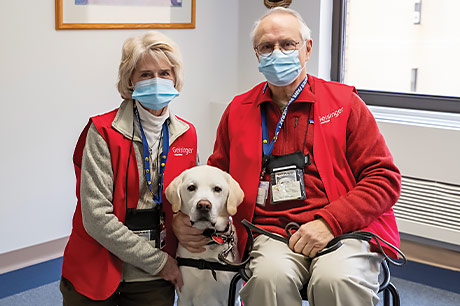At Geisinger, a Lab visit doesn’t always mean a blood draw.
By Paula Franken
Drake, a certified therapy dog, has been visiting with patients through Geisinger’s volunteer program since he was 2 years old. His humans, Jim and Connie Hepner of Sunbury, weren’t sure he was cut out for it at first because he was a high-energy puppy. “But now that he’s 5, he’s usually the calmest dog in the group,” Mr. Hepner laughs.
The Hepners have lots of experience with therapy dogs. They started working with them in 2004 and have been coming to Geisinger with their dogs since 2007. “We only see patients who request therapy dog visits and who’ve been cleared for them,” Mr. Hepner explains. “But we go all over the hospital. And whether it’s the Geisinger Janet Weis Children’s Hospital, palliative care, behavioral health or any other area, it’s always richly rewarding — the dogs help patients forget why they’re here.”
How to certify your pup to be a therapy dog
Want to share some puppy love with others? Your dog must be certified by either the Alliance of Therapy Dogs or Therapy Dogs International to be considered for the volunteer program at Geisinger. When an application is submitted, Mr. Hepner is part of the team that evaluates dogs and their handlers for the program. Once they’re approved, he takes new teams on extensive tours of the hospital to see where they feel most comfortable — and to teach them the ins and outs of what the role entails.
“You have to scan each room quickly as soon as you walk in,” he says. “How mobile is the patient? Where’s the medical equipment? What’s in the trash can? Is there food lying around? Are there IV lines to avoid? It’s the handler’s job to make sure the visit goes smoothly so the patients can enjoy their time with the dog.”
Helping people in the hospital every day
Dogs remain on their leads and with their handlers so patients can pet the dogs as much as they want. And if they’re under 40 pounds, the dogs can be placed right on patients’ beds (atop disposable mats) to make the interactions easier. “The dogs are great icebreakers,” Mr. Hepner says. “Most conversations are about them in the beginning. Then, patients often talk about themselves and what they’re going through. You know you’re doing good for them — sometimes just by listening.”
Unfortunately for Drake, he hasn’t been able to visit patients in nearly a year because of COVID-19 restrictions. So in early February, he, along with the Hepners and another dog therapy team, paid a visit to Geisinger staff to get the dogs reacquainted with the hospital. “Everything went extremely well,” Mr. Hepner says. “We’re all looking forward to getting back to our regular routines. In the meantime, my wife and I are volunteering as couriers, delivering flowers and gifts. But they don’t bring out the smiles like Drake does.”
Next steps:
This man went from nuclear submarine to hospital volunteer
Learn how you can volunteer at Geisinger

